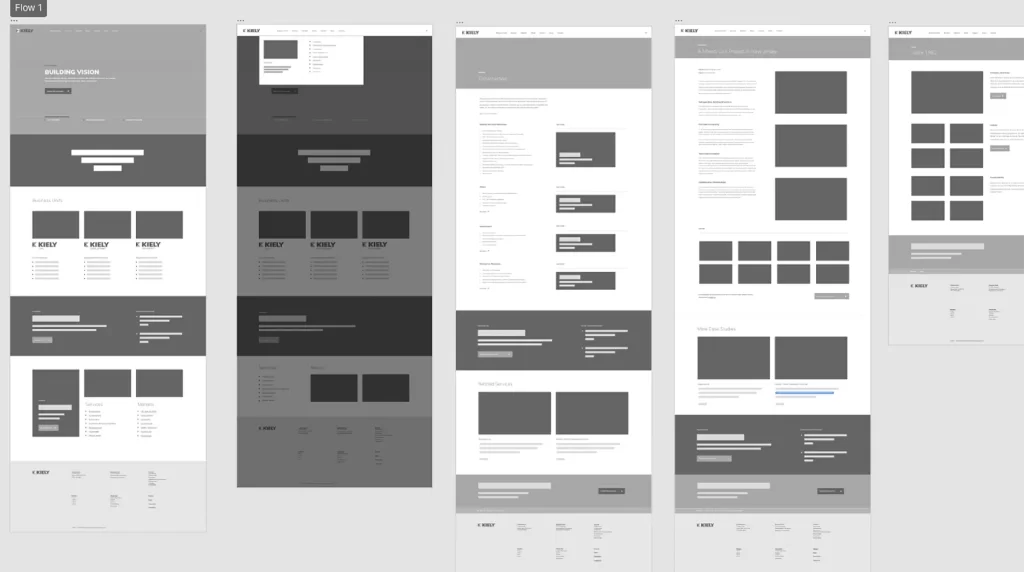When you picture building a new website for your business, it’s easy for the mind to jump straight to writing or design. But before any of that happens, there’s a step that often gets overlooked, even though it’s one of the most important in shaping how your site functions.
That step is wireframing.
It’s not flashy or public-facing, which is why it might be tempting to push aside. But skipping wireframes usually leads to confusion and extra revisions later on. Understanding what wireframes do and why they matter sets the stage for a smoother, more efficient website build.

What Is a Wireframe?
A wireframe is the first structural outline of your website. It’s a simplified visual layout that shows how content, navigation, and functionality fit together before any design begins. Think of it as the blueprint that organizes information and user flow, without the distraction of colors, images, or graphics.
At this stage, the goal isn’t simply to make the site look good; it’s also to make it work well. Wireframes map out where each element belongs, how users will navigate through the site, and how every section supports your goals. They give both you and your creative team a clear view of the foundation before building on top of it.
A wireframe can represent a single page or an entire site, depending on the project. For many websites, we typically wireframe only the key templates—like the homepage, a service page, and a contact page—to establish structure and layout patterns. For larger or more complex builds, additional wireframes show unique page types, user paths, or features.

In a wireframe, you’ll typically see placeholder boxes, notes, and text labels rather than finalized content or imagery. That simplicity is intentional. It keeps everyone focused on structure, hierarchy, and usability, the elements that matter most for performance and clarity.
Do I Need a Wireframe?
In most cases, yes. A wireframe translates strategy into something you can see. It’s where plans become tangible before time and resources are spent on design or development. Without it, conversations about layout, flow, or content placement happen too late, when changes are more labor-intensive to make.

Wireframes also align your entire project team. They turn abstract ideas into something everyone can react to. Designers see how functionality will take shape, writers understand where content belongs, and developers get a clear sense of what will be built. Most importantly, you can see how ideas are being implemented and give meaningful feedback before visuals or code come into play.
Even established businesses going through a redesign benefit from the wireframing process. Wireframes reveal where the current site creates friction, where users may get lost, and how new opportunities can be structured more effectively.

How Much Does Wireframing Cost?
Wireframing is scoped according to each project’s size and complexity. For advanced or custom sites, it’s often the most efficient way to align structure before moving into design and development. For smaller builds like basic WordPress or Squarespace sites, we may simplify or skip the wireframing phase. You’ll see it in our estimate as a line item if we’re recommending to include it.
The value of a wireframe isn’t measured in what it costs. It’s measured in what it prevents: confusion, miscommunication, and unnecessary rework. It’s one of those steps that can pay for itself before your new website ever launches.

What Are the Benefits of a Wireframe?
Wireframing is quietly one of the most valuable steps in the website process. Here’s why:
1. Clarity and Direction
Wireframes bring order to what can otherwise feel like an abstract process. They take strategy out of the conversation stage and put it into a visible, interactive layout that everyone can understand. That visual reference helps you see what’s working, what’s missing, and how each part of the site supports your goals. It eliminates ambiguity and gives both you and your creative team a shared understanding of what’s being built.
2. Alignment Across Teams
Once a wireframe is approved, everyone involved in the project knows what to do. Designers, writers, developers, and stakeholders are all working from the same plan. That alignment reduces friction, prevents conflicting interpretations, and keeps the project efficient. For clients, it also makes feedback easier because you’re reacting to structure and flow, not just visuals. Once the foundation is set, every discipline can focus on doing its best work within a clear framework.
3. Consistency and Usability
Wireframes establish rules for layout, hierarchy, and navigation that carry across the entire site. This consistency is what helps users feel oriented no matter where they land. Clear placement of headlines, calls to action, and content sections can help build trust and familiarity as people click from page to page.

4. Efficiency and Cost Control
Revisions are part of any creative process, but they’re far easier to manage early on. Wireframes allow for adjustments when changes are still simple to make, long before design or development time gets involved. The more confident everyone is in the structure, the less likely it is that major revisions will be needed later.
5. Stronger Final Results
When a website is built on a well-planned wireframe, everything that follows—design, content, development—feels more intentional. The final product not only looks better but performs better, because it was shaped around a structure designed to meet real goals. A strong wireframe gives your website the balance of creativity and functionality that makes it both engaging and effective.

A Smarter Website Build Starts Here
Most businesses have a clear sense of what they want their website to accomplish. The challenge is translating that vision into a creative and effective structure. Wireframing bridges the gap between planning and execution, turning strategy into something you can see and refine upfront. Ready to get started on your website the right way, the first time? So are we. Contact us today.

